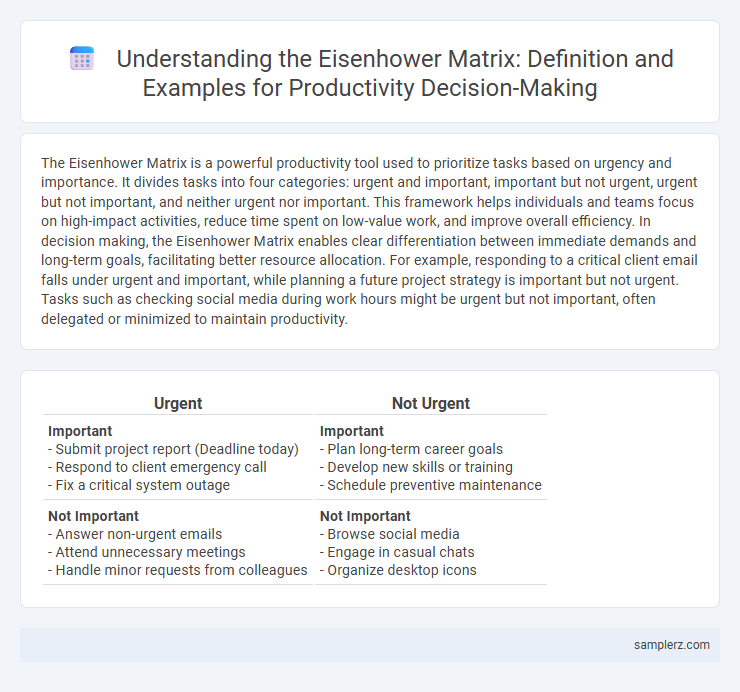The Eisenhower Matrix is a powerful productivity tool used to prioritize tasks based on urgency and importance. It divides tasks into four categories: urgent and important, important but not urgent, urgent but not important, and neither urgent nor important. This framework helps individuals and teams focus on high-impact activities, reduce time spent on low-value work, and improve overall efficiency. In decision making, the Eisenhower Matrix enables clear differentiation between immediate demands and long-term goals, facilitating better resource allocation. For example, responding to a critical client email falls under urgent and important, while planning a future project strategy is important but not urgent. Tasks such as checking social media during work hours might be urgent but not important, often delegated or minimized to maintain productivity.
Table of Comparison
| Urgent | Not Urgent |
|---|---|
|
Important - Submit project report (Deadline today) - Respond to client emergency call - Fix a critical system outage |
Important - Plan long-term career goals - Develop new skills or training - Schedule preventive maintenance |
|
Not Important - Answer non-urgent emails - Attend unnecessary meetings - Handle minor requests from colleagues |
Not Important - Browse social media - Engage in casual chats - Organize desktop icons |
Understanding the Eisenhower Matrix: A Productivity Powerhouse
The Eisenhower Matrix categorizes tasks into four quadrants based on urgency and importance, empowering users to prioritize effectively. By focusing on important but not urgent activities, individuals enhance long-term productivity and avoid burnout. Implementing this decision-making tool streamlines task management and fosters disciplined time allocation.
How the Eisenhower Matrix Streamlines Decision-Making
The Eisenhower Matrix streamlines decision-making by categorizing tasks into four quadrants based on urgency and importance, enabling individuals to prioritize effectively. By distinguishing between urgent-important, important-not-urgent, urgent-not-important, and not-urgent-not-important tasks, the matrix minimizes time spent on distractions. This structured approach enhances productivity by ensuring focus on high-impact activities that drive meaningful outcomes.
Real-Life Example: Daily Task Management with the Eisenhower Matrix
The Eisenhower Matrix categorizes daily tasks into four quadrants based on urgency and importance, helping prioritize effectively. For instance, urgent and important tasks like meeting deadlines are addressed first, while important but non-urgent tasks such as strategic planning are scheduled for later. Tasks that are urgent but less important, like routine emails, are delegated, and neither urgent nor important activities are minimized or eliminated.
Prioritizing Work Projects Using the Eisenhower Matrix
The Eisenhower Matrix categorizes work projects into four quadrants based on urgency and importance, enabling clear prioritization. Focus on completing tasks in the "Important and Urgent" quadrant first, followed by planning time for "Important but Not Urgent" projects to maximize long-term productivity. Delegating or deferring tasks in the "Urgent but Not Important" and "Not Urgent and Not Important" quadrants helps reduce distractions and increases overall efficiency.
The Eisenhower Matrix for Student Productivity: An Example
The Eisenhower Matrix categorizes tasks into four quadrants based on urgency and importance, helping students prioritize effectively. For example, studying for an upcoming exam falls into the urgent and important quadrant, while organizing notes might be important but not urgent. This approach enables students to allocate time efficiently, reducing procrastination and boosting overall productivity.
Example of Delegating Tasks Through the Eisenhower Matrix
In the Eisenhower matrix, tasks categorized as "Important but Not Urgent" are ideal for delegation, ensuring focus on critical priorities without overloading the individual. For example, a manager might delegate routine report preparation to a team member while concentrating on strategic planning. This approach maximizes productivity by aligning responsibilities with appropriate urgency and importance levels.
Using the Eisenhower Matrix to Tackle Email Overload
The Eisenhower Matrix helps prioritize emails by categorizing them into urgent and important, important but not urgent, urgent but not important, and neither urgent nor important. Focusing on emails in the urgent and important quadrant reduces stress and ensures critical tasks receive immediate attention. Delegating or scheduling time for less urgent emails optimizes productivity and minimizes distractions caused by constant inbox monitoring.
Eisenhower Matrix in Team Collaboration Scenarios
The Eisenhower Matrix enhances team collaboration by clearly categorizing tasks into urgent and important, enabling members to prioritize responsibilities effectively. Teams can delegate less critical tasks while concentrating collective efforts on high-impact projects, improving overall productivity. This structured approach minimizes misunderstandings and ensures alignment on deadlines and priorities within the team.
Avoiding Burnout: Eisenhower Matrix for Work-Life Balance
The Eisenhower Matrix categorizes tasks into urgent-important, important-not urgent, urgent-not important, and not urgent-not important to optimize decision-making and focus on what truly matters. Prioritizing important-not urgent tasks like self-care and downtime prevents burnout by ensuring regular breaks and relaxation are scheduled alongside work. This balanced approach enhances productivity while maintaining mental and physical well-being in demanding work environments.
Step-by-Step Example: Applying the Eisenhower Matrix to a Weekly Schedule
Prioritize tasks by categorizing them into urgent and important quadrants using the Eisenhower Matrix. For instance, schedule urgent and important tasks like project deadlines early in the week, important but not urgent activities such as strategic planning midweek, urgent but less important errands like responding to emails daily, and neither urgent nor important tasks like social media browsing for breaks. This method enhances time management by aligning weekly activities with productivity goals and reducing procrastination.

example of Eisenhower matrix in decision Infographic
 samplerz.com
samplerz.com